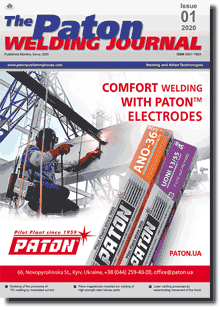| 2020 №01 (03) |
DOI of Article 10.37434/tpwj2020.01.04 |
2020 №01 (05) |

The Paton Welding Journal, 2020, #1, 31-36 pages
Journal The Paton Welding Journal
Publisher International Association «Welding»
ISSN 0957-798X (print)
Issue #1, 2020 (February)
Pages 31-36
Regularities of influence of slm process parameters on the formation of single layer from the high-temperature nickel alloy Inconel 718
S.V. Adzhamsky1,2 and G.A. Kononenko2,3
1Oles Honchar Dnipro National University 72 Gagarin Prosp., 49000, Dnipro, Ukraine. E-mail: pk_dnu@i.ua
2LLC «Additive Laser Technology of Ukraine» 144 Rybinska Str., 49000, Dnipro, Ukraine. E-mail: info@alt-print.com
3Z.I. Nekrasov Institute of Ferrous Metallurgy of the NAS of Ukraine 1 Starodubov Sq., 49000, Dnipro, Ukraine. E-mail: office.isi@nas.ua
In the work the varieties of additive technologies, their advantages and disadvantages were analyzed. The experiments on selective laser melting (SLM) are described in more detail in order to provide the required microstructure of the synthesized material. The modes that provide stable printing of a single layer were experimentally established. The optimal values of scanning speed and laser power for the alloy Inconel 718 were determined. 12 Ref., 6 Figures.
Keywords: SLM process, alloy Inconel 718, laser power, single track, specific volume power, maximum layer density
Received: 29.10.19
Published: 21.02.20
References
1. Thijs, L., Verhaeghe, F., Craeghs, T. et al. (2010) A study of the micro-structural evolution during selective laser melting of Ti-6Al-4V. Acta Mater., 58(9), 3303-3312. https://doi.org/10.1016/j.actamat.2010.02.0042. Simonelli, M., Tse, Y.Y., Tuck, C. (2014) Effect of the build orientation on the mechanical properties and fracture modes of SLM Ti-6Al-4V. Materials Sci. and Eng. A, 616, 1-11. https://doi.org/10.1016/j.msea.2014.07.086
3. Frazier, W.E. (2014) Metal additive manufacturing: A review. J. of Materials Eng. and Performance, 23(6), 1917-1928. https://doi.org/10.1007/s11665-014-0958-z
4. Parimi, L.L., Clark, R.G.A.D., Attallah, M.M. (2014) Microstructural and texture development in direct laser fabricated IN718. Mater. Charact., 89, 102-111. https://doi.org/10.1016/j.matchar.2013.12.012
5. Wu, M.W., Lai, P.H., Chen, J.K. (2016) Anisotropy in the impact toughness of selective laser melted Ti-6Al-4V alloy. Materials Sci. and Eng. A, 650, 295-299. https://doi.org/10.1016/j.msea.2015.10.045
6. Chlebus, E. et al. (2011) Microstructure and mechanical behaviour of Ti-6Al-7Nb alloy produced by selective laser melting. Materials Characterization, 62(5), 488-495. https://doi.org/10.1016/j.matchar.2011.03.006
7. Vilaro, T., Colin, C., Bartout, J.D. As-fabricated and heattreated microstructures of the Ti-6Al-4V alloy processed by selective laser melting. Metallurgical and Materials Transact. A, 42(10), 3190-3199. https://doi.org/10.1007/s11661-011-0731-y
8. Qiu, C., Adkins, N.J.E., Attallah, M.M. (2013) Microstructure and tensile properties of selectively laser-melted and of HIPed laser-melted Ti-6Al-4V. Materials Sci. and Eng. A, 578, 230-239. https://doi.org/10.1016/j.msea.2013.04.099
9. Santos, E.C. et al. (2006) Rapid manufacturing of metal components by laser forming. Int. J. of Machine Tools & Manufacture, 46, 1459-1468. https://doi.org/10.1016/j.ijmachtools.2005.09.005
10. Zakiev, S. et al. (2006) Modelling of the thermal processes that occur during laser sintering of reacting powder compositions. Appl. Phys. A, 84, 123-129. https://doi.org/10.1007/s00339-006-3586-0
11. Meier, H., Haberland, C. (2008) Experimental studies on selective laser melting of metallic parts. Materialwissenschaft und Werkstofftechnik, 39(9), 665-670. DOI: 10.1002/mawe.200800327. https://doi.org/10.1002/mawe.200800327
12. Islam, M., Purtonen, T., Piili, H. (2013) Temperature profile and imaging analysis of laser additive. Physics Procedia, 41, 828-835. https://doi.org/10.1016/j.phpro.2013.03.156
